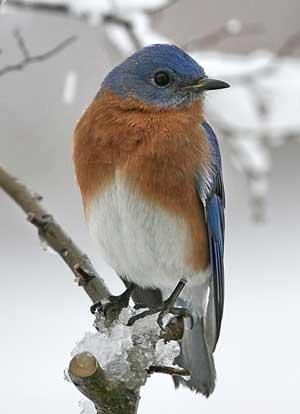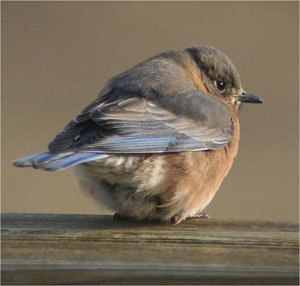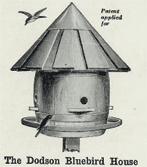QUICK TIPS: Leave nestboxes up all winter long (with entrance hole facing south or east, but away from prevailing winds) to provide a place for birds to shelter during cold weather. Insulate them by closing up ventilation holes and adding a layer of dried grass on the floor.
How do birds that don’t migrate stay warm in the winter?
Birds have enough feathers to keep them warm in the winter IF they have enough food and IF they remain dry and out of severe winds. To stay warm, they fluff up their feathers, draw their head in or tuck it under a wing, and shiver. They may scrunch down by bending their legs, or tuck one foot up under their feathers to further reduce heat loss. They may also huddle together with other birds. During the night, the body temperature of birds like bluebirds and chickadees may drop 10-15 degrees, and their metabolism slows down to conserve energy. (This is called nocturnal hypothermia.)
Bluebirds spend about 50% of their lives roosting. (Pitts, T.David) A roost is a place or support where birds settle down to rest or sleep. A communal roost is a bunch of birds roosting together. Some birds roost on branches of trees like pines, cedars or oak, or in shrubs/vines. Others roost in cavities. A roost box is like a nestbox, only it is designed specifically for roosting. See links to plans.


There are not a lot of reports of large flocks of bluebirds using roost boxes, but bluebirds often roost in a regular nestbox, especially in northern states. They may also roost in a box in the daytime during particularly inclement weather (e.g., high winds.)
Chickadees, titmice, nuthatches and downy woodpeckers may also use nestboxes for roosting. (They are solitary roosters.)
Evidence that a box is being used for roosting includes downy feathers (which sometimes fall out when birds are preening and fluffing), fecal material, and seeds/food residue. Birds often enter a cavity to roost just before sunset. They may enter or leave several times before settling in for the night. They leave right after sunrise.
Advantages of a Box for Roosting
A box or cavity not only provides protection from the elements – it also helps keep them safe from hungry predators. Thus it may be best to just leave boxes up all winter so they can be used for roosting if desired. Also, that way you won’t have to go out in January or February to put them back up before nesting starts.
Weather proofing standard nestboxes helps, as the birds sit on the floors. To some extent, deeper nestboxes will keep the drafts from chilling birds on the floor of the nestbox.
Options to prepare a box for winter roosting:
- A nestbox will do. It doesn’t need a hole in the bottom of pegs – if it’s really cold, and multiple birds roost together, they will stay warmer on the floor of the box.
- Seal up the ventilation holes (don’t forget the floor). Duct tape on the OUTSIDE can do the trick nicely (if it sticks to the waterproofing). You can use rolled caulking (e.g. “Mortite”) but again only on the outside of the box!
- Add an inch or so of SMALL wood chips (avoid sawdust and commercially sold cedar bedding, and do not put in large wood chips that might get stuck in the hole and trap a bird inside) or a layer of soft grass, or some moss.
- Or you can line the floor with silver foil (which insulates and seals), bringing it up to the front of the nestbox under the entrance hole, and then add some dry grass.
- You can also put a 1/2″ Styrofoam, cut to fit, on the bottom of the nestbox.
Location and Predator Protection:
- Mount roost boxes on poles with predator guards to keep the contents from being eaten, and to prevent mice from wintering in the box. (More on deterring mice.)
- Face the entrance away from prevailing winds – south is probably best for greatest warmth.
If multiple birds roost in one box, will the ones on the bottom suffocate?
On occasion, especially during prolonged periods of extremely cold weather, one or more dead bluebirds are found in nestboxes or roost boxes. Some speculate they may have suffocated. However, photos show that when multiple birds (e.g., 2-21) pile into a cavity, they fan their heads out. It is more likely that dead birds found in a box during winter died due to food shortages, dehydration, or disease. In severe winters, large numbers of bluebird can die. For example, in NW TN an estimated 44% of bluebirds in one area died during the winter of 1960-61, according to a study by Dr. David Pitts (Toops, Bluebirds Forever). Drainage holes in the corners of the box floor can provide additional access to clean air if suffocation is a concern.
Some roost box plans: Most roost boxes have a larger floor size and are deeper. In some designs, the hole may be at the bottom to retain warmth. Joe Huber did not believe that Eastern Bluebirds used boxes that had roost holes near the floor (a concept thought to help prevent upward heat loss). Having two holes will allow fast exit and escape, and also help accommodate multiple birds. A roost box may have perches inside but they are probably not needed. The door should open for cleaning.
- Fawzi Emad – probably the best design
- Special roosting boxes was at http://www.paulnoll.com/I-birds.html
- Winter Roost design from Woodworking for Wildlife

- In The Bluebird, Zeleny recommended a box with inside floor dimensions of 10×10″, and depth of 18-24″, with the entrance hole slightly above floor level (see discussion above), and a horizontal perch (made of 1/2″ wooden dowels) or staggered perches below the hole to help with entry.
- A friend has 6 Eastern bluebirds roosting in a six sided, large box similar to one that Dodson used to sell in the 1920s (see photo on right). They chose this box over half a dozen regular NABS style nestboxes.
Note: Downy woodpeckers seldom if ever nest in boxes, but they will roost in unused boxes, usually arriving right before dusk. Sometimes they excavate the interior a bit, and may chomp on any interior perches. If they enlarge the entrance hole, reduce it with a hole guard. I have had downies roost in a nestbox that had a front that swiveled to put the hole at the bottom for the winter.
More Information:
- Fall and Winter Bluebirding
- Roost box design by Fawzi Emad
- Flocks of Bluebirds
- Downy Woodpecker biology
- Nestbox designs, pros and cons
- Planting to provide berries in winter
- Feeding suet and recipes
- Mice and rats in nestboxes
- Predator Guards
- Hole Reducers
- Predator and Problem ID and Solutions
References:
- Eastern Bluebird, Wild Bird Guides, Ritchison
- The Bluebird, Zeleny
- Email from Joe Huber to Fawzi Emad indicating he counted 21 birds leaving a roost box one morning, 10/01/2000
– Linda Ruth, Bluebird_L, 2006
